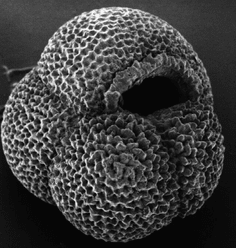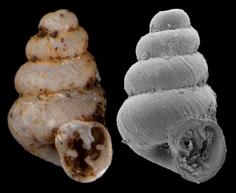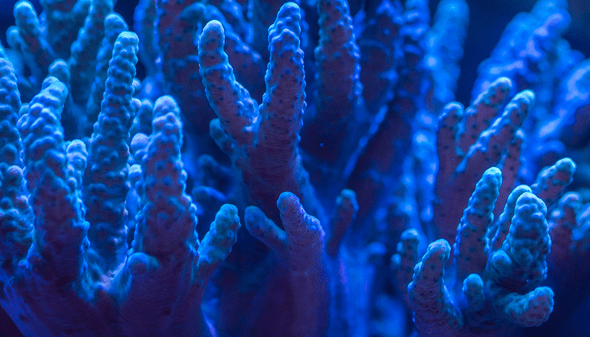Strontium dating of foraminifera, shells & corals
Strontium dating (as enabled by the 87Sr/86Sr ratio of marine carbonates) can be used to date various marine samples based on the premise that the mixing of oceanic strontium occurs relatively rapidly through time compared to the residence time of oceanic strontium. This creates a uniform global marine 87Sr/86Sr ratio at a given point in time; the fluctuations over millions of years represent a record of global Earth tectonic, erosional, and weathering processes. Since marine organisms are at equilibrium with the surrounding ocean water, they reflect the 87Sr/86Sr during their lifetime and secular variations in 87Sr/86Sr ratios are observed over the past 600 million years.

Foraminifera are particularly useful in paleoclimate and paleooceanic studies as they are a locus for many geochemical proxies. Their abundance and distribution in records are often measured as a herald of changes in ocean environment. Their carbonate tests have a complex interplay with aqueous CO2 and pH (via structural changes, Mg/Ca, and boron isotopes (δ11B ). The oxygen isotopic composition of their tests (δ18O) is in turn influenced by temperature . They can also be used to identify petroleum due to the short-lived nature of certain species, which can be used to identify paleoenvironments within different rock strata. In all cases, reliable dating of foraminifera is vital to these applications. In a recent study by Şafak & Nurlu (2021), the authors used strontium ratios to date foraminiferal biostratigraphy within carbonate rocks along an unconformity in southeastern Turkey. The carbonate rocks contained abundant planktonic foraminifera of several species, allowing for the reconstruction of distinct foraminifera transitions across the Early to Middle Eocene. This stratigraphic sequence was confirmed through 87Sr/86Sr, resulting in an age of ~45–52 million years ago. In another study by Eidvin (2020), the authors aimed to confirm biostratigraphic sequences of foraminifera with strontium dating. In some sequences (covering the Oligocene and Miocene), the strontium dating produced rather large ranges as the 87Sr/86Sr curve had a relatively low gradient during that time – adding more uncertainty to the age ranges. On the other hand, sequences covering the Pleistocene were more reliable given the steep 87Sr/86Sr curve over this period. Uncertainty typically ranges from 500ka for younger material to several million for older and can be made worse by post-depositional sediment reworking.

Shells are used widely in paleoclimate studies as well as archaeological research. Given the continuous, seasonal growth rings on shells, they have the potential to provide a vital high resolution biological proxy for past oceanic conditions including δ18O- and microstructure- based paleothermometry. In archaeological studies, shells are commonly used for personal and tool adornments, have a history of being traded as a form of currency and are a natural indicator of marine dietary sources. For both disciplines, dating entire shells and shell layers provides distinct information. In a study by Vanhaeren et al. (2004), the authors used strontium dating to distinguish between fossil shells and coastal collected shells from personal adornments within a burial site in western France. The authors were able to conclude that the shells were collected along beaches far away from the burial site during the Late Upper Palaeolithic. The dating of shells with 87Sr/86Sr can be limited in certain environments with poor mixing. For example, Meknassi et al. (2018) found offsets in modern ages with epibenthic bivalves and gastropod shells living within coastal areas with limited water mass circulation and relatively strong continental interactions from lagoons and fjords – highlighting that local environmental biases must be considered as part of the dating process.
Similar to shells, corals are extensively studied in paleoclimatic research given both their seasonal growth bands and the long-lived nature of some species which provides the potential for longitudinal records of subannual resolution. Growth density changes provide information on how optimally productive the environment was and isotopes can be used to reconstruct specific climate indices (e.g. δ18O for temperature, δ13C for photosynthesis and calcification). In a recent study by Fan et al. (2019), the authors utilized 87Sr/86Sr to date a long sequence of a coral core from the northern South China Sea. The coral core represented a series of different coral growths through time, dated from the early Miocene (19.6 million years) at the base to the present at the core top. This dating procedure was not without its challenges, the researchers identified and removed various segments that exhibited diagenetic alterations (which can re equilibrate the sample material) and weathering (which can open gaps in the record) before a final (optimal) subset of samples could be dated.

Contact us today about your Strontium Chronology research!
| Sample Type | Sample Size | Sample Preparation |
| Foraminifera | Minimum 5-10 mg | For the best results, make sure your samples are clean and free from clay particles and other detritus. Package in vials (preferably with screw tops), microcentrifuge tubes, or counting slides |
| Shells (bivalves, gastropods, brachiopods) | 100mg | |
| Corals |
References
Eidvin, T. 2020. Biostratigraphy and Strontium Isotope Stratigraphy (SIS) of the upper part of the Brygge Formation, Kai and Naust formations in well 6507/5-1 and cored section of the Naust Formation in well 6507/5-J-1 H from the the Skarv Field
(Revfallet Fault Complex, Norwegian Sea shelf). NPD stratigraphic report.
Fan, T., Yu, K., Zhao, J., Jiang, W., Xu, S., Zhang, Y., Wang, R., Wang, Y., Feng, Y., Bian, L. and Qian, H., 2020. Strontium isotope stratigraphy and paleomagnetic age constraints on the evolution history of coral reef islands, northern South China Sea. GSA Bulletin, 132(3-4), pp.803-816.
Şafak, Ü. and Nurlu, N., 2021. Strontium isotopes and planktonic foraminiferal biostratigraphy of Eocene carbonate rocks from the Adıyaman–Malatya vicinity (southeast Turkey) and chronostratigraphic implications. Journal of African Earth Sciences, 179, p.104186.
Vanhaeren, M., d’Errico, F., Billy, I. and Grousset, F., 2004. Tracing the source of Upper Palaeolithic shell beads by strontium isotope dating. Journal of Archaeological Science, 31(10), pp.1481-1488.
Image References
Foraminifera: https://commons.wikimedia.org/wiki/File:Foraminifera_hg.jpg
Gastropod Shell: https://commons.wikimedia.org/wiki/File:Gastrocopta_sharae.jpg
Corals: https://www.pexels.com/photo/corals-920161/
